Next stop Ise-jingu
I had read a lot about this sacred place and all I have in my
mind is that Ise is like the Vatican City for the Catholics. The morning we
left Kyoto was also going to be the first time I jumped on a car and hit the
road in Japan. Couple of things on the road were similar but some others were definitely
not.
The first thing that caught my attention was the GPS.
I know, there’s nothing special about a talking GPS but perhaps what I found
interesting was the voice and the tiny anime character who was giving us
directions. My friend told me it was an old version and that hence she was not
going to use it, because some parts of the way to Ise had recently changed.
I found it a bit disappointing that my friend had to buy
a complete new GPS in order to get a new version of the road. I hope my friend
was mistaken but if it’s true – what a disappoinment. Still, the GPS looked
very new to me, but then again I’m coming from Europe and I haven’t seen
anything like that before I have to say (I mean the anime character on the GPS hehe).
Japanese roads are very different. I mean there’s nothing
special from the tarmac and paint but it’s the whole experience of seeing
things differently. I’d like to add that my friend was ALWAYS driving at 80
Km/h and only in rare occasions she’d speed up a bit (95 km/h). None of the
countries I have lived and driven before have been like that.
Another thing regarding the Japanese motorway is that
everything is sooooo clean and in many parts you can see a big wall that
separates the two sides of the motorway.
I don’t really know what the purpose of that is but it’s a bit weird. Perhaps to prevent accidents or cars jumping from one side of the road to the other?
As usual I HAD TO eat in the morning and I HAD TO eat onigiri. Yes kombi-onigiri! If you’re not fuzzy about it not being 100% fresh (like Japanese people) then go for it –
they are delicious and they come with this special envelope that keeps the rice
ball and the seaweed separate from each other, keeping the freshness and crispiness
of the seaweed.
 |
| Onigiri on the way to Ise - おにぎりの車 |
 |
| Clever packing! seaweed doesn't touch the rice ball until you remove the plastic wrap. Genius! |
Ise-Jingu 伊勢神宮 (Naikū (内宮) and Gekū (外宮))
I was sleeping when we got to the town and my friend
woke me up so I might have missed a bit (if there was anything special to see)
At first glance Ise has nothing special. It actually looks like a little town
but with many cars that I suppose, due to the date we went to visit the Shrines in Ise.
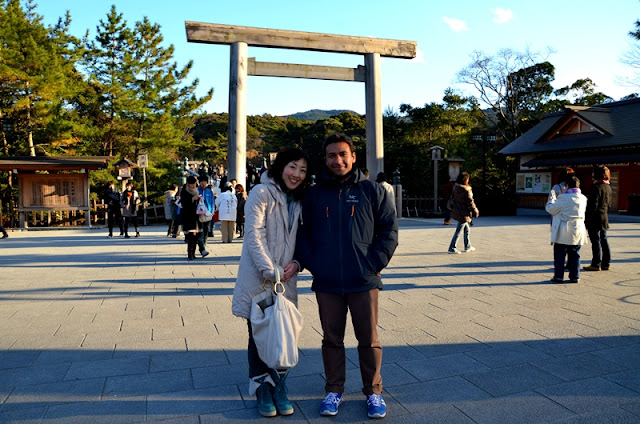 |
Naiku - 内宮 and the Big Torii with the Uji Bridge 伊勢神宮 in the background
|
If you want to do it the Japanese way you have to
visit the main two temples. First, you have to go to Naikū (内宮) - Kotai Jingu which the shrine dedicated to the god Amaterasu-omikami.
Afterwards, you’re supposed to go to the other one located some 6kms apart from
the other one. The other shrine’s name is Gekū (外宮) Toyouke Daijingu and
it was built to worship Touyoke no omikami. In Ise there are many more shrines,
in total there are 123 shrines but most of the people only visit those two
shrines.
 |
| Naiku - 内宮 - Main Shrine |
We luckily found a place in the car park and we rushed
to the first shrine Kotai Jingu. Coming from the western world where the
Church, Temple, Mosque, etc always has a big building I couldn’t see anything
from the distance. Instead, there was a smell of greenness, forest, bamboo,
river, rocks, logs, wood – Nature. The first thing you see is the Big Torii and
the Uji bridge you have to cross. On the other side, there are just trees and people.
 |
Naiku - tree - Main shrine
|
Huge trees are everywhere you see, a lot of people are
everywhere too but the greenness of the place makes it look beautiful. The
temperature was not too cold, not too warm – just perfect.
My apologies to everyone for not being able to show
you any picture from the main shrine but I was respectful to the gods. However,
I learnt it the hard way. I wanted to take a picture of the sacred mirror and
my friend looked at me with fire eyes. From that moment on, I knew I could not
take pictures in sacred places. That
beauty remains in my memories. I’m sure you can find images of the shrine but
there’s a feeling of guilty so I decided to refrain from it.
There I was, in the middle of the most important Shrine in Japan and all that was around me were trees, stones, birds, life in general and sacred
buildings made out of wood taken from the forest we were standing.
If you compare the western vision of sacred place and
the Japanese (and I believe Chinese and Korean as well) sacred places the
difference is quite notorious. It’s remarkable to see how Japanese lived with
such high-tech and then they come here to say their yearly prayers. A place
that nothing equals the best preserved forests in any other country in the
world.
 |
| Outside Naiku |
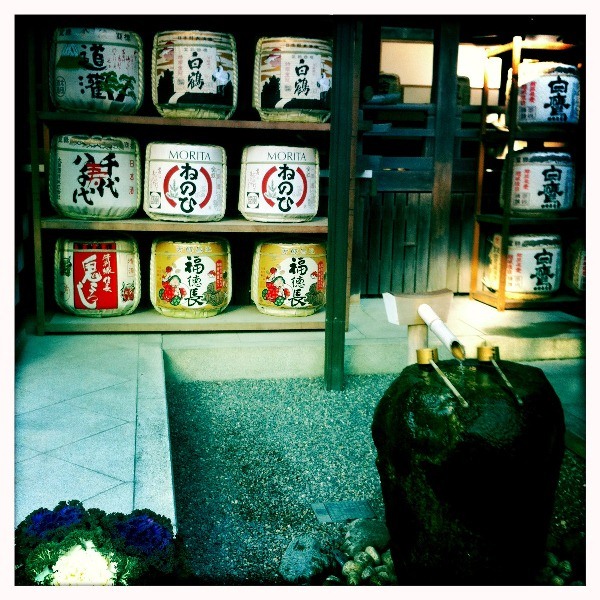 |
| Holy sake offered to the Shinto gods in Naiku |
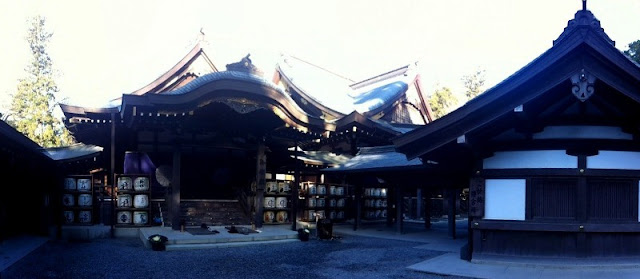 |
| More Shrines around Naiku |
Like I said in the beginning of my blog I was going to
meet my dear friend, who is a deep Shinto follower. She explained me many
things about the shrines not only in Ise but also in Kyoto, Okayama, Miyajima,
etc. One of the main important things she said is that the Ise Shrine is
destroyed and rebuild every couple of years. This is the philosophy behind the
religion. Nothing lasts forever. Actually, even though, it was close to Xmas
they were working on the new shrine that is going to replace the current site.
Even though, she didn’t tell me what they do with the logs from the old site, I
presume the use them to do Shinto woodcrafts that you can buy in the shop.
I was born and raised Catholic but I didn’t reconfirm
as I do not believe in the Church and my mother is partly ok with that. I
guess, it would only matter if I marry a catholic girl, but at this point there’s
no need to re-confirm something I don’t believe in.
I’m saying this because in Ise I felt something I hadn’t
felt since I climbed up the Kerepakupai Merú also known as Angel Falls (highest
waterfall on earth) in Venezuela. There’s something in that place that makes me
shiver and Ise did it the same way. Even though there were tons of people you
could feel some inner-peace and that the trees were trying to communicate through
the movement created by the soft wind of that day. What I like about Shinto is
that there’s no human-shape-face-body attach to the mirror. That means, you
have to imagine how you think Amaterasu looks like.
From (Naikū (内宮) to Gekū (外宮)
After Naiku we drove to Gekū (外宮) the other shrine 6 kms apart from the other shrine and it was again
the same feeling.
Once we were done with the two main shrines I was starving so we went to
the town to buy something. A special note here about Ise. When you get there,
buy whatever you need since everything closes very early and nothing’s opened
till late.
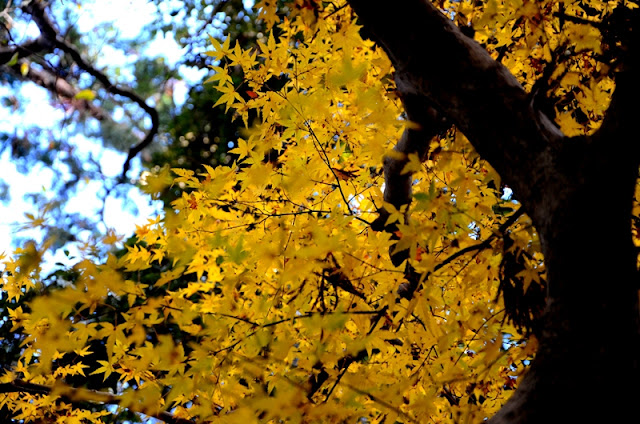 |
| Yellow leaves - inside Geku 外宮 |
 |
五十鈴川 (Isuzu River) at Ise (伊勢神宮) Geku Shrine (外宮)
|
 |
| Geku Shrine - Shinto Priests - Ise Jingu |
 |
| Stone stairs - Geku - Ise Jingu |
The Ise commercial road is very cosy and you can feel the old Japanese style.
Sadly, we couldn’t do much in there since it was quite late and both my friend
and I wanted to have a relaxed night in the hotel. Yet, I had the chance to see a pure breed Akita Inu (very typical Japanese dog) in the street. I had never seen such a dog before so it was quite shocking when such a beast walked next to me. The breed seem quite stable and calmed, many people padded it and he would not even turn at all. I guess he was used to it. However, he barked a couple of times because the owner was eating and didn't share the food with him. Funny dog indeed and I dog to have if I ever consider to move to Japan. I don't think the picture does any justice but the dog size is huge. The man in front of him - his owner - was a tall man.
 |
| Akita Inu - Japanese dog in Ise Town - 秋田犬の伊勢神宮 |
The way to the bath was a bit long….. Go downstairs and the stairs were
as narrow as nothing I’d ever stepped on before, but I loved it. The
house/hotel we stayed ended up being over 150 years old – so try to imagine. In
the room there gave us Yukata – which of course I used and you can see it in
the picture where I’m enjoying some great sake. We didn’t drink too much, just
talked about the differences in culture and how religion differs from one
continent to another. Another day in Ise-Jingu would await us the next day –
typical Ise-Jingu food, yes Sir, check it out in the next post.













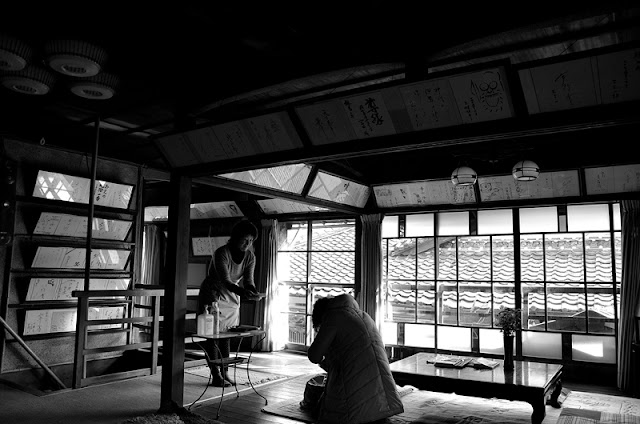


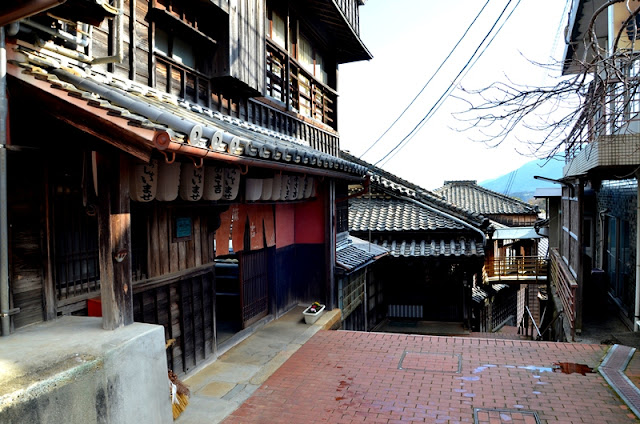
No comments:
Post a Comment